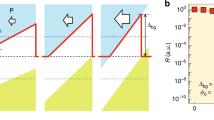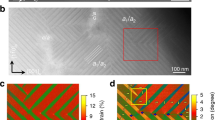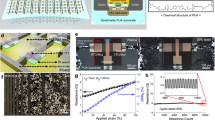Abstract
Electrostriction is a property of dielectric materials whereby an applied electric field induces a mechanical deformation proportional to the square of that field. The magnitude of the effect is usually minuscule (<10–19 m2 V–2 for simple oxides). However, symmetry-breaking phenomena at the interfaces can offer an efficient strategy for the design of new properties1,2. Here we report an engineered electrostrictive effect via the epitaxial deposition of alternating layers of Gd2O3-doped CeO2 and Er2O3-stabilized δ-Bi2O3 with atomically controlled interfaces on NdGaO3 substrates. The value of the electrostriction coefficient achieved is 2.38 × 10–14 m2 V–2, exceeding the best known relaxor ferroelectrics by three orders of magnitude. Our theoretical calculations indicate that this greatly enhanced electrostriction arises from coherent strain imparted by interfacial lattice discontinuity. These artificial heterostructures open a new avenue for the design and manipulation of electrostrictive materials and devices for nano/micro actuation and cutting-edge sensors.
This is a preview of subscription content, access via your institution
Access options
Access Nature and 54 other Nature Portfolio journals
Get Nature+, our best-value online-access subscription
$29.99 / 30 days
cancel any time
Subscribe to this journal
Receive 51 print issues and online access
$199.00 per year
only $3.90 per issue
Buy this article
- Purchase on Springer Link
- Instant access to full article PDF
Prices may be subject to local taxes which are calculated during checkout




Similar content being viewed by others
Data availability
The data supporting this study’s findings are available from the corresponding authors on reasonable request.
Code availability
The code used for the creation of the physical and atomic-scale models is available from the corresponding authors on reasonable request.
References
Ramesh, R. & Schlom, D. G. Creating emergent phenomena in oxide superlattices. Nat. Rev. Mater. 4, 257–268 (2019).
Yang, M. M. et al. Piezoelectric and pyroelectric effects induced by the interface polar symmetry. Nature 584, 377–381 (2020).
Li, F., Jin, L., Xu, Z. & Zhang, S. Electrostrictive effect in ferroelectrics: an alternative approach to improve piezoelectricity. Appl. Phys. Rev. 1, 011103 (2014).
Lehmann, W. et al. Giant lateral electrostriction in ferroelectric liquid-crystalline elastomers. Nature 410, 447–450 (2001).
Yimnirun, R., Moses, P. J., Newnham, R. E. & Meyer Jr, R. J. Electrostrictive strain in low-permittivity dielectrics. J. Electroceram. 8, 87–98 (2002).
Li, F., Jin, L., Xu, Z., Wang, D. & Zhang, S. Electrostrictive effect in Pb(Mg1/3Nb2/3)O3-xPbTiO3 crystals. Appl. Phys. Lett. 102, 152910 (2013).
Zednik, R. J., Varatharajan, A., Oliver, M., Valanoor, N. & McIntyre, P. C. Mobile ferroelastic domain walls in nanocrystalline PZT films: the direct piezoelectric effect. Adv. Funct. Mater. 21, 3104–3110 (2011).
Li, F. et al. Ultra-high piezoelectricity in ferroelectric ceramics by design. Nat. Mater. 17, 349–354 (2018).
Zhang, Q. M., Bharti, V. & Zhao, X. Giant electrostriction and relaxor ferroelectric behaviour in electron-irradiated poly(vinylidene fluoride-trifluoroethylene) copolymer. Science 280, 2101–2104 (1998).
Korobko, R. et al. Giant electrostriction in Gd-doped ceria. Adv. Mater. 24, 5857–5861 (2012).
Yavo, N. et al. Large nonclassical electrostriction in (Y, Nb)-stabilised δ-Bi2O3. Adv. Funct. Mater. 26, 1138–1142 (2016).
Korobko, R. et al. In situ extended X-ray absorption fine structure study of electrostriction in Gd-doped ceria. Appl. Phys. Lett. 106, 042904 (2015).
Hadad, M., Ashraf, H., Mohanty, G., Sandu, C. & Muralt, P. Key-features in processing and microstructure for achieving giant electrostriction in gadolinium-doped ceria thin films. Acta Mater. 118, 1–7 (2016).
Santucci, S., Zhang, H., Sanna, S., Pryds, N. & Esposito, V. Enhanced electromechanical coupling of TiN/Ce0.8Gd0.2O1.9 thin film electrostrictor. APL Mater. 7, 071104 (2019).
Sata, N., Eberman, K., Eberl, K. & Maier, J. Mesoscopic fast ion conduction in nanometer-scale planar heterostructures. Nature 408, 946–949 (2000).
Domínguez, C. et al. Length scales of interfacial coupling between metal and insulator phases in oxides. Nat. Mater. 19, 1182–1187 (2020).
Haeni, J. H. et al. Room-temperature ferroelectricity in strained SrTiO3. Nature 430, 758–761 (2004).
Cancellieri, C. et al. Electrostriction at LaAlO3/SrTiO3 interface. Phys. Rev. Lett. 107, 056102 (2011).
Junquera, J. & Ghosez, P. Critical thickness for ferroelectricity in perovskite ultrathin films. Nature 422, 506–509 (2003).
Fong, D. D. et al. Ferroelectricity in ultrathin perovskite films. Science 304, 1650–1653 (2004).
Mani, B. K., Chang, C. M., Lisenkov, S. & Ponomareva, I. Critical thickness for antiferroelectricity in PbZrO3. Phys. Rev. Lett. 115, 097601 (2015).
Zhang, W. & Ouyang, J. In Nanostructures In Ferroelectric Films For Energy Applications(ed. Ouyang, J.) 163–201 (Elsevier, 2019); https://doi.org/10.1016/B978-0-12-813856-4.00006-5
Ji, D. et al. Freestanding crystalline oxide perovskites down to monolayer limit. Nature 570, 87–90 (2019).
Sanna, S. et al. Enhancement of chemical stability in confined δ-Bi2O3. Nat. Mater. 14, 500–504 (2015).
Sanna, S. et al. Structural instability and electrical properties of epitaxial Er2O3-stabilized Bi2O3 thin films. Solid State Ion. 266, 13–18 (2014).
Varenik, M. et al. Dopant concentration controls the quasi-static electrostrictive strain response of ceria ceramics. ACS Appl. Mater. Interfaces 12, 39381–39387 (2020).
Li, Q. et al. Giant thermally enhanced electrostriction and polar surface phases in La2Mo2O9 oxygen ion conductors. Phys. Rev. Mater. 2, 041403(R) (2018).
Chen, B. et al. Large electrostrictive responses in lead halide perovskites. Nat. Mater. 17, 1020–1026 (2018).
Das, T. et al. Anisotropic chemical strain in cubic ceria due to oxygen-vacancy-induced elastic dipoles. Phys. Chem. Chem. Phys. 20, 15293–15299 (2018).
Kraynis, O. et al. Modeling strain distribution at the atomic level in doped ceria films with extended X-ray absorption fine structure spectroscopy. Inorg. Chem. 58, 7527–7536 (2019).
Born, M. & Mayer, J. E. Zur gittertheorie der ionenkristalle. Z. Phys. 75, 1–18 (1932).
Chapman, J. B. J., Cohen, R. E., Kimmel, A. V. & Duffy, M. D. Improving the functional control of aged ferroelectrics using insights from atomistic modeling. Phys. Rev. Lett. 119, 177602 (2017).
Liu, S. & Cohen, R. E. Response of methylammonium lead iodide to external stimuli and caloric effects from molecular dynamics simulations. J. Phys. Chem. C 120, 17274–17281 (2016).
Genreith-Schriever, A. & De Souza, R. A. Field-enhanced ion transport in solids: reexamination with molecular dynamics simulations. Phys. Rev. B 94, 224304 (2016).
Nosé, S. A unified formulation of the constant temperature molecular dynamics methods. J. Chem. Phys. 81, 511–519 (1984).
Hoover, W. G. Canonical dynamics: equilibrium phase-space distributions. Phys. Rev. A 31, 1695–1697 (1985).
Plimpton, S. Fast parallel algorithms for short-range molecular dynamics. J. Comput. Phys. 117, 1–19 (1995).
Acknowledgements
This research was supported by the BioWings project, funded by the European Union’s Horizon 2020, Future and Emerging Technologies programme (grant no. 801267), and by the Danish Council for Independent Research Technology and Production Sciences for the DFF—Research Project 2 (grant no. 48293). N.P. and D.V.C. acknowledge funding from Villum Fonden for the NEED project (no. 00027993) and from the Danish Council for Independent Research Technology and Production Sciences for the DFF—Research Project 3 (grant no. 00069 B). V.E. acknowledges funding from Villum Fonden for the IRIDE project (no. 00022862). N.G. and J.V. acknowledge funding from the GOA project ('Solarpaint') of the University of Antwerp. The microscope used in this work was partly funded by the Hercules Fund from the Flemish Government. D.J. acknowledges funding from the FWO Project (no. G093417N) from the Flemish Fund for Scientific Research. D.C. acknowledges TOP/BOF funding from the University of Antwerp. This project has received funding from the European Union’s Horizon 2020 Research Infrastructure—Integrating Activities for Advanced Communities—under grant agreement no. 823717-ESTEEM3. We thank T. D. Pomar and A. J. Bergne for English proofreading.
Author information
Authors and Affiliations
Contributions
H.Z., N.P. and V.E. conceived the idea and designed the project. H.Z. and S.S. prepared samples and characterized their electromechanical properties. N.G. performed STEM measurements and analysed STEM–EELS results. D.J. assisted with processing of HAADF–STEM data analysis. D.C. performed statistical analysis of the EDX results under the supervision of N.G. and J.V. D.-S.P., P.M., D.D. and D.A.R. performed XRD and RSM characterization. H.Z., I.L. and I.E.C. performed atomic-scale simulations and analysis. D.V.C. performed finite-element simulations. A.R.I., I.L. and P.M. developed the analytical model. H.Z., V.E. and N.P. wrote the manuscript with input from all authors. All authors have read and agreed to the published version of the manuscript.
Corresponding authors
Ethics declarations
Competing interests
The authors declare no competing interests.
Peer review
Peer review information
Nature thanks the anonymous reviewers for their contribution to the peer review of this work. Peer reviewer reports are available.
Additional information
Publisher’s note Springer Nature remains neutral with regard to jurisdictional claims in published maps and institutional affiliations.
Extended data figures and tables
Extended Data Fig. 1 STEM analysis of the heterostructures.
a. HAADF-STEM images for NGO/CGO[ESB/CGO]10 viewed along the [110] and [001] directions of the substrate from left to right, respectively. b. STEM-EELS compositional maps. For each sample, the leftmost image is the HAADF signal acquired simultaneously with the EELS measurement, followed by cerium M4,5 in red, erbium M4,5 in yellow, and neodymium M4,5 in green (colour code: Ce: red; Er: yellow, Nd: green). c. STEM-EDX compositional maps.
Extended Data Fig. 2 Electrostriction Measurements.
a. Electrostrictive response of NGO/CGO/[ESB/CGO]7 under an alternating electric field. The strain developed at the second harmonic of the applied electric field. b. Field-induced stress as a function of the electrical field for NGO/CGO/[ESB/CGO]N measured at 1 Hz. The field-induced stress increases linearly with an increase in the squared electric field. No saturation was observed within the measured electric field range, regardless of the modulation length. The dash-dotted lines represent linear fittings of the measured results.
Extended Data Fig. 3 Electrostriction measurements for heterostructures with different stacking sequences.
Comparison of electrostriction coefficients for thick CGO films and bulk materials Multilayer* denotes NGO(100)/ESB/CGO/…/CGO, where ESB was deposited as the first layer.
Extended Data Fig. 4 Fatigue measurements.
Electromechanical response of NGO/CGO/[ESB/CGO]7 as a function of time. a. Electric field. b. Electromechanical stress in response to an electric field at 1 Hz c. Electromechanical stress as a function of the measured cycles at 1, 50, and 200 Hz. All measurements were performed by applying a sinusoidal electric field with a constant amplitude of 17.4 kV/cm.
Extended Data Fig. 5 Calculated field-induced strains in different directions.
a. CGO20; b. ESB20; c. heterostructure (Λ = 2.33 nm). An electrical field was applied along the (100)-crystallographic direction. All lattice parameters were allowed to relax during the application of the electrical field. εxx, εxy, and εxz denote the strain developed along the X-, Y-, and Z-axis, respectively when the electric field is applied along with the X-axis. The Cartesian axes X, Y, and Z correspond to the (100), (01-1) and (011) crystallographic directions, respectively. Note that the lattices of CGO20, ESB20, and the heterostructure exhibit similar deformation in response to an electric field, that is, contract along the (100)-crystallographic direction and expand along with the (011) and (01-1)-crystallographic directions.
Extended Data Fig 6 Electrostriction as a function modulation length for heterostructures with different crystal structures.
a. fluorite: CGO20/YSZ8; b. perovskite: SFTO10/BYZO10; c. garnet: GGMO10/LSFO10; d. spinel: MGMO10/ZAZO10. The chemical formula for YSZ8, SFTO10, BYZO10, GGMO10, LSFO10, MGMO10 and ZAZO10 are \(({{\rm{Zr}}}_{0.92}^{4+}{{\rm{Y}}}_{0.08}^{3+}{){\rm{O}}}_{1.96}^{2-}\), \({{\rm{Sr}}}_{1.0}^{2+}{({\rm{Fe}}}_{0.1}^{3+}{{{\rm{Ti}}}_{0.9}^{4+}){\rm{O}}}_{2.95}^{2-}\), \({{\rm{Ba}}}_{1.0}^{2+}{({\rm{Y}}}_{0.1}^{3+}{{{\rm{Zr}}}_{0.9}^{4+}){\rm{O}}}_{2.95}^{2-}\), \({{\rm{Gd}}}_{3.0}^{3+}({{\rm{Ga}}}_{4.5}^{3+}{{{\rm{Mg}}}_{0.5}^{2+}){\rm{O}}}_{11.75}^{2-}\), \({({\rm{La}}}_{2.5}^{3+}{{\rm{Sr}}}_{0.5}^{2+}){{{\rm{Fe}}}_{5.0}^{3+}{\rm{O}}}_{11.75}^{2-}\), \({{\rm{Mg}}}_{1.0}^{2+}({{\rm{Ga}}}_{1.8}^{3+}{{{\rm{Mg}}}_{0.2}^{2+}){\rm{O}}}_{3.90}^{2-}\), \({{\rm{Zn}}}_{1.0}^{2+}({{\rm{Al}}}_{1.8}^{3+}{{{\rm{Zn}}}_{0.2}^{2+}){\rm{O}}}_{3.90}^{2-}\), respectively. The defects are generated at random within the heterostructures. The insets schematically show the unit cell of the ideal structure. All the lattice parameters are allowed to relax during the application of the electrical field. Note that the optimal modulation length yielding maximized electrostriction coefficient (Mxx) is material dependent.
Extended Data Fig. 7 Ion distribution within the heterostructures.
Radial distribution function of heterostructures as a function of modulation length (Λ). The first, second, and third peaks correspond to the cation–anion, anion–anion, and cation–cation distances, respectively. No electric field was applied.
Extended Data Fig. 8 Mechanism of elastic dipole and electric dipole formation.
a. An ideal tetrahedron with cations having equivalent distances and three C2 symmetry axes present. Schematic illustration of the elastic dipole formation resulting from tetrahedral deformation along the b. (100), c. (010), and d. (001) directions. The off-site displacements of the cations result in local-symmetry breaking. Note that replacing one of the ions with Gd will result in a structure with three variants that are equivalent to the distortion of Ceria without Gd.
Supplementary information
Supplementary Information
Supplementary Sections 1–6, including Supplementary Figs. 1–6 and Supplementary References.
Rights and permissions
Springer Nature or its licensor holds exclusive rights to this article under a publishing agreement with the author(s) or other rightsholder(s); author self-archiving of the accepted manuscript version of this article is solely governed by the terms of such publishing agreement and applicable law.
About this article
Cite this article
Zhang, H., Pryds, N., Park, DS. et al. Atomically engineered interfaces yield extraordinary electrostriction. Nature 609, 695–700 (2022). https://doi.org/10.1038/s41586-022-05073-6
Received:
Accepted:
Published:
Issue Date:
DOI: https://doi.org/10.1038/s41586-022-05073-6
This article is cited by
-
Giant electrostriction-like response from defective non-ferroelectric epitaxial BaTiO3 integrated on Si (100)
Nature Communications (2024)
-
Auxetic piezoelectric effect in heterostructures
Nature Materials (2024)
-
Lead-free Zr-doped ceria ceramics with low permittivity displaying giant electrostriction
Nature Communications (2023)
-
Engineered interfaces for heterostructured intermetallic nanomaterials
Nature Synthesis (2023)
Comments
By submitting a comment you agree to abide by our Terms and Community Guidelines. If you find something abusive or that does not comply with our terms or guidelines please flag it as inappropriate.



